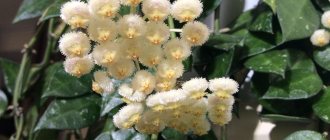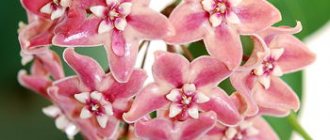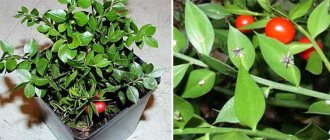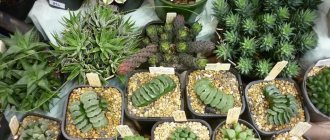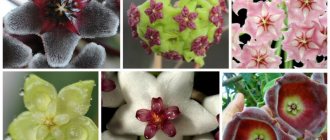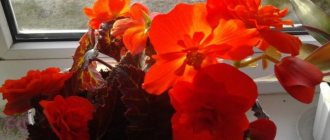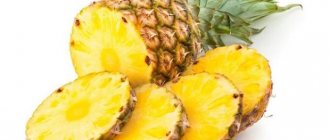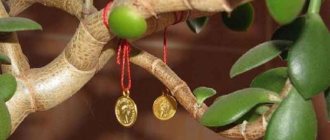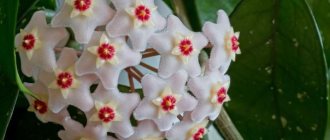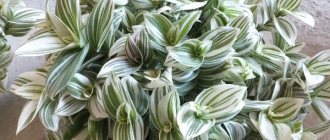What does hoya look like and bloom in its natural environment?
In summer, hoya blooms with fragrant, porcelain-white, pinkish, yellow-greenish and other shades of bisexual flowers, collected in umbrella inflorescences. Both the botanical description of the flowers of the Hoya plant and numerous photographs confirm that they have a star-shaped appearance, consist of petals and a central five-membered crown rising above them. The average diameter of flowers is from 1 to 2 cm, except for the majestic appearance (8 cm).
While the hoya plant is blooming, a pleasant perfume aroma prevails around the bush or vine. Representatives of certain species are even able to secrete nectar, which is attractive to many insects.
In its natural environment, the plant can reach 10 meters in length. Young shoots are immediately colored brown-violet, and as they mature, they acquire a rich green tint, and then gradually become lignified. The foliage is fleshy, oval, with a pointed apex. The average length of the leaves is from 5 to 15 cm, width - from 3 to 8 cm. Both the color and the leaves are dense, have a matte appearance, which gives the visual impression that they are cast from wax.
Familiarize yourself with some types and varieties of hoya from photos with official names to get a general impression of the plant before getting acquainted in detail:
Characteristic
Botanical name: Hoya Wayetii. Hoya is popularly called wax ivy.
The description of the liana-like culture includes several distinctive qualities:
- shoots are cylindrical, 3-4 mm thick, reaching 10 m in length;
- in young specimens the branches are flexible, in adults they are lignified, so at the beginning of growth they are immediately placed in the right direction;
- the flowers are miniature and round, covered with fluff, bright red, odorless, secrete sweet and sticky nectar;
- buds are collected in dense inflorescences-umbrellas of 15-20 pieces;
- the leaves are elongated, sharp at the tips, 15-16 cm long;
- in young specimens the leaf blade is reddish in tone, in old specimens it is bright green with an emerald edging.
Flowering is long and abundant - begins in late spring and ends in autumn. During this period of life, the plant cannot be moved from one place to another so that the inflorescences do not fall off.
Is it possible to keep hoya at home and the qualities of wax ivy
Many cultivars are grown indoors. This plant has decorative qualities and is often used for landscaping offices and offices. There are a large number of legends and superstitions regarding the issue of growing Hoya at home, many of which, oddly enough, contradict each other.
For example, according to one belief, this flower “expels” men from their homes (husband, sons). According to other legends, culture is able to pacify resentment and envy. Still other sources, when asked whether it is possible to keep hoya or wax ivy at home, say that this plant is a source of happiness in the family, so the ideal place for growing it is the marital bedroom.
Which version to take into account is an individual decision of the gardener. But whatever the choice, it will not cancel the fact that exotic flowers can captivate everyone with their beautiful color, even the most demanding florist.
Brief information about the family
Hoyas (Hóya) are evergreen natives of the tropics: sparse forests of subtropical and tropical Asia, Central America, Polynesia, Australia. The genus was first described in 1810. By 2015, about 700 descriptions of Khoi were included in the catalog of decorative floriculture.
The family received its exotic name in honor of the English gardener Thomas Hoy (1750 - 1822), famous for his collections of greenhouse plants.
Ground shrubs and vines up to 10 m long, succulents and epiphytes - the appearance of representatives of this family is very different.
Hoya has 2 characteristic features:
- "waxy" leaves;
- beautiful “porcelain” star-shaped flowers with a strong, pleasant aroma.
Popular types and varieties of indoor hoya plants: photos, names and descriptions
Today, approximately 200 species of hoya plant are known. For growing indoors, the most popular among them are:
Noua bella (hoya beautiful).
Noua carnosa (hoya fleshy).
The following types of this plant are cultivated much less frequently at home:
Hoya imperialis (majestic hoya).
Hoya longifolia (long-leaved hoya).
Hoya lacunosa (hoya concave)
Hoya pubicalyx (fuzzy cup hoya).
Hoya kerrii (Hoya Kerry).
Hoya multiflora (multiflorous hoya).
The type of hoya called beautiful is a low-growing, branched evergreen shrub, covered with small foliage (reaches a length of about 3 cm) and having drooping shoots (their length varies from 30 to 50 cm). The leaves have a fleshy structure, lanceolate-ovate shape, and a convex surface. The foliage on the shoots grows very densely. The flowers resemble small stars in appearance, the color of the petals is white and the core is crimson. The color is collected in umbrellas, each of which has from 7 to 9 “stars”.
Compare the description of the beautiful Hoya species with the photos below:
This is an epiphytic plant; in nature, its usual habitat is tree branches in tropical forests. In indoor conditions, it is grown as a hanging crop.
Within the species Noua bella, many bush-type varieties have been bred. The main difference between them is the color of the leaves.
Types of Hoya for indoor growing
As mentioned above, in natural conditions there are many types of wax ivy. Below are the most popular varieties, often grown by gardeners as indoor plants. Read the article: Garden delphinium - growing seedlings from seeds for beginners.
Hoya carnosa
The leaves of the plant are small in size and oval in shape. Their hard, thick surface is dark green in color with characteristic silver strokes. The flower petals are white and the crown inside the calyx is pink. The unpretentious fleshy hoya feels great at home. For this reason, it is most often chosen by florists for breeding.
Today, scientists have studied several forms of the Hoyacarnosa plant. In particular, the variegated hoya (Hoyacarnosa Variegata) looks absolutely stunning. This flower is not only beautiful, but also hardy
When caring for Hoya Tricolor (Variegata Tricolor), you need to pay attention to its slow growth. But such a plant is capable of forming new flower umbrellas throughout the year.
Scientists have not yet reached a consensus on whether Hoya compacta is a subspecies of the Hoyacarnosa plant or should be considered an independent species. This form is in great demand among flower growers due to its remarkable endurance and high decorative qualities.
Hoya bella
Many florists dream of growing this hanging plant, Hoya Bella, at home. In nature, it is found in Myanmar and Indonesia. This type of wax ivy is characterized by the presence of small leaf blades.
The corollas and flower crowns are white; the range of petal colors can include both pink and dark red tones. Luxurious beautiful Hoya can be grown at home without problems with the right approach to caring for the flower.
Hoya Kerry (Hoya kerrii)
The spherical umbrella inflorescence can contain 15 - 25 flowers. Their paint (yellowish, lemon, soft pink) directly depends on the degree of illumination.
Hoya Multiflora (Hoya multiflora)
The shape of the leaves is linear-lanceolate, they have well-defined veins, and there are strokes of contrasting color on the surface of the plates. The flowers have a light or straw-yellow color, long petals, bright edges. The outwardly curved crown has arcuate spurs. An inflorescence can contain up to 40 buds.
Hoya Imperialis (Hoya imperialis)
The flowers are very large, they are characterized by a dark red color, becoming somewhat greenish on the outside. Their aroma is extremely pleasant and sweet. In nature, Imperial Hoya grows in Borneo.
Hoya concave (Hoya lacunosa)
The wonderful Hoya Lacunosa (Pitted, Concave), grown as a house flower, has a cascading shape. The densely growing vines of the plant are covered with diamond-shaped leaves with curled edges. The shoots, about 6 m long, are red-brown in color. Flowers collected in an umbrella are characterized by the presence of light, fleecy petals and a yellowish center.
Hoya linearis
Linear Hoya, also called Hoya Linearis, looks very unusual. Its foliage is very light. The length of the hanging lashes can reach about 6 m. The leaves of the plant are quite narrow (5 cm long, 0.5 cm wide). The color of young specimens is almost white; as they age, they darken slightly. In nature, the flower grows in the Himalayas.
Hoya Graceful (Hoya gracilis)
The spectacular Hoya Gracilis (Graceful) is found naturally in Sulawesi, Philippines. It is a powerful vine, strewn with oblong-oval leaves (pointed at the ends) with a light green, somewhat spotted color. With sufficient lighting, their tint becomes pinkish, and the stains acquire greater contrast. About 20 flowers with long pedicels are formed in inflorescences.
Bush varieties of hoya and vines
Hoya bella var. Louis Buis is a beautiful hoya bush variety with leaves that have golden spots in the center and a reddening midrib in good light conditions.
Hoya bella Variegata is a plant with foliage with a thin edging of white or yellowish tint.
Hoya bella Wee is a variety of beautiful hoya with especially small leaves, which are placed in a whorl not in twos, as usual, but in threes.
Hoya fleshy has become widespread due to its unpretentiousness to growing conditions and ease of care. Unlike the previous species, this is not a bush plant, but an evergreen climbing vine.
Its length can be 6 m, so when growing a crop you should take care of support. The foliage of the plant is oval, thick, hard, dark green, has a shiny surface, reaches about 8 cm in length. The inflorescences are umbrellas, which contain 20 flowers with a strong, pleasant aroma. The main color of the petals is white, with a pink crown located in the central part.
Evaluate in the photo what varieties and varieties the fleshy Hoya has:
The images show those that are most popular in home gardening.
Hoya carnosa Variegata (hoya variegata) , in particular its variety called "Crimson Queen", which is famous for its unusually delicate cream-colored edging along the edges of its rich green leaves.
Hoya carnosa Tricolor (Hoya tricolor) and its variety with the original name “Exotic”, which is loved by many professional and amateur gardeners thanks to its scarlet flowers and green-pink-cream foliage.
The majestic hoya flower is also a climbing vine. It is densely dotted with lanceolate-oval foliage, the length of which reaches 15 cm and the width - up to 8 cm. The color of this plant is considered the largest among the known species: the diameter of the flowers is 8 cm. The peduncles are long, flower umbrellas are formed on them, in each of which contain from 8 to 10 smooth star-shaped flowers with deep red petals and a white central crown.
On the reverse side, the petals are decorated with an admixture of green or yellow. Hoya imperialis is widely known for its pleasant perfume scent.
Descriptions of popular varieties of this type of hoya with photos and official names are presented below - study and choose the green “pet” that is most suitable for your greenhouse:
Hoya imperialis var. rauschii features wavy-edged foliage and white-green flowers with pink and purple hues.
Hoya imperialis "Borneo Red" is popular because it grows very quickly and has purple flowers with a fruity, sweet scent.
Hoya imperialis var . Palawan is famous for its yellow-golden flowers with an original slightly reddish tint.
The photo below shows Hoya longifolia:
This is a climbing plant, the thin shoots of which contain a large amount of milky sap. The liana is densely dotted with lanceolate-shaped foliage, smooth edges, rich green color, and a fleshy structure without visible veins. The length of each leaf is approximately 13 cm and the width is about 2 cm.
The surface is without pubescence and is not shiny. Fragrant flowers in quantities from 5 to 12 pieces are collected in a spherical umbrella. The diameter of each flower varies from 1.5 to 1.7 cm, and there is pubescence on the surface. The color of the petals is white, the central crown is pale pink or pure white.
Find out what long-leaved hoya looks like in colorful photos.
Concave Hoya is an epiphytic plant, very branched, with flexible branches that look like very densely growing cascading lashes. The foliage is diamond-shaped, thickened, with edges turning inward, and rich green in color. The length of each leaf does not exceed 6 cm. The inflorescence is an umbrella, shaped like a fluffy ball. One umbel contains 15 to 20 fuzzy white or cream flowers with a white crown topped with a yellow center.
Read the description of popular varieties of concave hoya with photos below:
“Tova” is a hybrid with monochromatic foliage and a light green color.
"Eskimo" is a cultivar with leaves decorated with a marble pattern of a lighter shade.
Snowdrop flower: description of species
What color snowdrops are depends on the variety and growing conditions.
On a note! In total, there are 18 species of snowdrops in the amaryllis family (in Latin they are called “galanthus” from the word “milk”).
Here are some of them:
- Alpine snowdrop (Galanthus alpinus, Galanthus schaoricus). It grows among bushes and in open areas in the lower and middle mountain zones in Central and Southern Europe, Ciscaucasia. This is the most popular variety in modern gardening. Blooms in early spring, distinguished by bluish and dark green leaves;
- Caucasian snowdrop (Galanthus caucasicus). It grows in the mountains of Central Transcaucasia, on the outskirts of Tbilisi and in the Stavropol region. Flat white leaves of a linear type with a bluish tint, up to 30 cm long. Flowering lasts two weeks in early April;
- Bortkevich's snowdrop (Galanthus bortkewitschianus). It blooms in the first half of spring in beech forests, on humus, in the upper reaches of the Kamenka River, in the North Caucasus. Petals are lanceolate, wedge- or ovate, glaucous and dark green;
- Cilician snowdrop (Galanthus cilicicus = Galanthus rizehensis). It blooms already at the end of winter on the edges, among bushes and in the foothills of Cilicia, Trabzon, Batumi, Asia Minor. Dark green leaves, white petals with a green spot;
- Elwesa snowdrop (Galanthus elwesii). Mainly distributed in Southeast Europe, on the islands of the Aegean Sea, Asia Minor, Moldova, and Southern Ukraine. Bears the name of the collector Elvez. The species differs in height - reaches 25 cm, in the size of the petals - they are large, spherical and very fragrant. Flowering lasts up to 4 weeks; a total of up to 15 forms of the plant are cultivated in European gardens;
Snowdrop sprouts in the garden.
- folded snowdrop (Galanthus plicatus). It is found on the edges and among shrubs of Romania, Moldova, Crimea, and blooms in early spring. The flowers are large, curved downwards, with a strong aroma. Cultivated since 1592, there are more than 10 forms;
- broadleaf snowdrop (Galanthus platyphyllus, Galanthus latifolius). Distributed in the subalpine zone and alpine zone, in gorges and on the slopes of the Caucasus Range. The peduncle reaches a height of 22 cm. The most decorative in gardening;
- Icarian snowdrop (Galanthus ikariae). It grows on the Greek islands - Skyros, Andros, Ikaria, in forests and forest edges on sandy and rocky soils. Reaches a height of 21 cm. White flowers with a green spot go down to half the leaf;
- white snowdrop (Galanthus nivalis). It is found in Central and Southern Europe, Ciscaucasia in the Alpine zone on the edges and bushes. Flowering from the end of March can last up to 30 days. Cultivated since 1500. The number of varieties and forms reaches 50. Peduncles with 12 leaves are white and large, with a yellow spot.
On a note! There is a wide variety of flower colors and shapes. What kinds of snowdrops there are and their names can be found out from encyclopedias and photo galleries on the Internet, this makes it easier to choose an option for your flowerbed and garden.
How to properly care for Hoya at home
Caring for a hoya flower at home is generally not difficult and will not take much time, since the plant is considered not capricious. For a green “pet,” a well-lit location is suitable. The plant is tolerant of direct sunlight. Although caution in this regard will not hurt: due to exposure to direct ultraviolet radiation, burns may occur on the hoya. To prevent such a disastrous outcome, it is recommended to provide diffused light for the flower at noon by shading the window in one of the following ways:
- Tracing paper.
- Tulle.
- Marley.
An eastern or western window sill is well suited for growing hoya flowers at home. You cannot place the plant on a window facing north: due to a lack of sunlight, flowering will not occur at all. If you purchased a bush or vine that was in a shaded place in the store, it is not recommended to immediately place it in a part of the room with intense lighting - you need to gradually increase the amount of light so that the plant can gradually, without stress, adapt to new conditions.
When it comes to the question of how to properly care for hoya at home, temperature conditions play an important role. Temperature: in summer the plant loves warmth (+18...+23 °C), in winter - a cooler atmosphere (+14...+18 °C).
Many species can overwinter even at + 10 °C, but hoya is more thermophilic: if it is not provided with a warm winter, it can completely shed its foliage.
Air humidity in general is not a significant factor in growing a plant. But, as in the case of temperature, the Hoya beautiful species requires special conditions - the flower loves a humid environment, grows better in it and blooms more profusely. In summer, during the period of shoot growth, bushes or vines should be regularly sprayed with a spray bottle.
Proper care for wax ivy hoya, organized at home, means that once every six months the plant needs to be bathed and completely immersed in water.
To do this, fill the bath with warm water (from +30 to +40°C) and place the green “pet” in it (even at the stage before the buds appear!) in a flowerpot for 40 minutes. After this time, the shoots must be lifted and “hung” to dry, and the flowerpot with rhizomes must be left for another 1.5 hours. You can do it a little differently: just lower the pot under water heated to the temperature indicated above for 2 hours, and give the foliage a warm shower. This procedure will help stimulate flowering.
The necessary conditions
Growing Hoya Vayeti in an apartment or house will be successful if certain conditions are met.
Hoya vajeti photo and description
The plant prefers high humidity - 75-80%. In spring and summer, the crown is irrigated with warm water every three days. In extreme heat, this procedure is carried out every day.
In the cold season, one spray per month is sufficient.
You can give warm showers to adult flowers - once every 30 days. Before washing the stems and leaves, cover the soil with polyethylene.
Temperature:
- During the phase of active growth of green mass and flowering—22-25°C.
- In autumn and winter, the flower needs coolness - 15-16°C.
The room is regularly ventilated. Before this, the hoya is taken to another place, because sudden changes in temperature will cause massive leaf fall.
The light should be diffused, daylight, at least 10 hours a day. Therefore, they are grown on windowsills where there is sunlight in the morning and evening. In winter they are illuminated with a fluorescent lamp.
Watering and fertilizing when caring for hoya (with video)
An important aspect of caring for a home hoya flower is watering: moderate in summer, even less in winter. A feature of the culture is its ability to tolerate moisture deficiency well. In the warm season, you need to water the plant as the soil dries out, but it is still better not to let the earthen clod dry out. In order for the vine or bush to enjoy abundant flowering next season, a minimal amount of liquid will be required during winter dormancy. If the soil is waterlogged, the plant may begin to shed both leaves and shoots. Water for irrigation should be used that has settled and is soft.
Feeding: during the growth period - from March to September - once every 2 weeks. Hoya needs to be fertilized with mineral compounds during the growing process.
The ready-made mixture “For flowering succulents” can be purchased at a flower shop, or you can make it yourself at home, taking into account the recommended ratio of components:
- 2% magnesium.
- 10% nitrogen.
- 11% phosphorus.
- 18% potassium.
The solution must be poured into the pot along the edge. During winter dormancy, the plant does not need to be fertilized. Also, fertilizing is not needed at all if the crop is transplanted annually into a new, not yet depleted substrate.
To learn how to organize proper care for your hoya, watch the video below:
Possible problems during cultivation
Problems with Hoya Pubicalyx often arise, especially in the autumn.
Pests
Scale insects, which multiply especially quickly in dry air, cause great harm to hoya. They eat fleshy leaves and lay their larvae on them, the plant withers, turns pale and dies.
Another pest is the mealybug, which leaves white mucus on the leaves. These whitish insects are noticeable on the foliage and are completely removed by washing the flower with a soapy solution.
Powdery mildew is caused by insect pests
Other problems
Due to stagnant moisture and lack of loosening of the soil, Hoya Pubicalix is prone to root rot and gray mold.
Too dry air causes the leaf blades to dry out, and yellowing or paleness may indicate a lack of certain mineral elements in the soil.
Hoya propagation by apical and stem cuttings
There are three ways to propagate hoya flowers at home:
- By apical or stem cuttings.
- Seeds.
- Sheets.
Propagating a hoya plant by cuttings is considered the least difficult and most reliable way to grow a new specimen. It is necessary to take into account two main characteristics of the cutting:
- Age.
- Size.
Both apical and stem cuttings chosen for propagation should not be too young - their tissues tend to rot when they try to root. Therefore, it is better to give preference to cuttings that are mature, but have not yet had time to lignify.
The size of the rooting material should not be long. It is better to take cuttings that have two nodes covering two pairs of leaves. If you plan to propagate plant species with large foliage, then you can make an exception and take cuttings, keeping one node at a time.
How dates are collected
The bulk of dates are harvested by cutting off the entire fruit-bearing cluster.
In North Africa, where palm trees originate, fruit pickers use forked sticks or ropes to climb onto the palm tree and cut the clusters, carefully lowering the branches to helpers below
Residents of California and Saudi Arabia, where date palms grow on artificial plantations, harvest the crop using mechanized means: harvesting saddles, retractable ladders, mobile lifts. The harvest period lasts from August to November.
Canarian date palm
All dates on one bunch and branches on a palm tree ripen at different times, so you have to return to one plant more than once.
How to take hoya cuttings to properly root the plant
In the question of how to properly cut hoya, special attention should be paid to pruning the cuttings. The best place for roots to appear is considered to be the area located under the node itself. Therefore, you need to leave a couple of centimeters of the stem under it, and cut off the rest. After a new shoot appears from the axil of the first node, you can cut off the second node and also root it.
Rooting is possible in one of two ways:
- Immediately in the substrate (at soil temperature +20...+25 °C).
- In water (at a temperature of + 22 ° C).
The first option is considered to be more reliable. Before rooting hoya cuttings, you need to prepare the soil according to one of the “recipes”:
- Mix equal parts of sphagnum moss (or peat), vermiculite (or perlite), fine expanded clay (or polystyrene foam).
- Combine fine expanded clay (1/5 part), perlite or vermiculite (1/5 part), planting soil (3/5 part).
The prepared substrate must be breathable so that the cuttings do not rot. Perlite or vermiculite will help ensure this soil property. You should also take care of the proper soil moisture, but the higher the level of its breathability, the faster the water evaporates from it. This problem can be solved using a plastic bag (how exactly will be discussed later).
Before rooting, for 100% results, you can treat the cuttings with Kornevin, but this is not necessary.
Landing rules
To grow the elegant Hoya Vayeti, you need loose and light soil, which you can prepare yourself - mix turf soil, humus, peat and sand in a ratio of 2:1:1:1.
Many gardeners take a ready-made substrate for planting ornamental flowering plants.
The best location would be the southern or southwestern part of the house, as this variety loves a lot of light. During lunch hours, it is covered from scorching rays to avoid burns. When kept on a north window, artificial additional lighting will be required.
Planting home hoya with cuttings and caring for the plant
Planting hoya using apical or stem cuttings is carried out as follows: the cutting is placed in a plastic bag filled with a slightly moistened substrate so that the lower node is covered with soil. The bag is then placed horizontally, and after 10 days it will be possible to observe the appearance of roots.
You can do it differently by planting the cuttings in a flowerpot. Drainage is placed at the bottom of the container, then a substrate is placed into which the cutting goes deep, as in the previous version. To maintain moisture, a transparent plastic bag is placed loosely over the pot.
After 14-21 days, you can get a germinated cutting, ready for planting in a permanent place of growth in soil prepared using one of the previously described technologies.
Rooting in water is done like this. The container with the liquid is wrapped in foil on all sides, and holes are made in the top of the wrapper for the cuttings. Planting materials treated at will with Kornevin are lowered into the vessel so that the lower node is under water. A plastic bag is also placed loosely on the container (to allow free air flow). Roots will appear after 14 days. You need to transplant the cutting into the ground immediately, since the roots will become very fragile and may break off.
Reproduction methods
Lacunosa tove and other varieties can be propagated by layering, cuttings and even leaves.
- The easiest way to do this is by layering. Take a closer look at the branches of this plant - you will see many growth points on them in the form of short roots. It’s as if they are waiting for the soil to be next to them so that they can begin to take root in it. If you place a pot of soil next to the hoya and bend a branch with roots towards it, the roots will begin to quickly lengthen and will soon reach the soil surface. At this moment, the rooting of the new plant begins.
- It is easy to propagate this flower by cuttings. Cut off the top of any branch and immerse it in clean water or a heavily moistened substrate. The length of the spine must be at least five centimeters. The root panicle forms quickly. After just a week, you can transplant the sprout into a separate pot. During the formation of the root panicle, you can cover the cutting with transparent film or a glass jar.
- Few people use the leaf propagation method in practice, although a leaf also produces a completely healthy plant. In this case, you just need to immerse a fragment of the sheet into the ground at an angle. This method is not popular because it takes a very long time to wait for the first sprout from a leaf. To speed up rooting, try using heteroauxin. Make sure the soil is always moist.
- Hoya lacunosa in nature reproduces by seeds, but at home the seed propagation method is not used.
Hoya propagation by seeds and leaves at home
Hoya propagation by seeds at home is carried out using well-dried seed material in the year of its collection. The substrate can be prepared according to one of the above “recipes”. Shoots appear after 7 days.
As soon as the first shoots appear, you need to monitor the soil moisture: do not overwater it, but also do not let it dry out. The container with seedlings should be placed in a warm and well-lit place.
To prevent the occurrence of fungal diseases, it is recommended to treat them with some preparation containing copper in accordance with the instructions on the package. After 90 days, the seedlings will already have several pairs of leaves - from this moment they can be transplanted into separate flowerpots.
Hoya propagation from leaves is considered the most difficult and lengthy process. It is recommended to take leaves of those plants that live in the natural environment. Therefore, breeders use this method. But amateur florists also have the opportunity to experiment with house plants. The leaf is planted in a loose substrate, maintaining an angle of 45 ̊. After 2-3 weeks, roots will appear. The problem with this propagation method is that a leaf that has taken root may not sprout for several years. To speed up this process, drop one drop of “Heteroauxin” onto the base of the leaf using a pipette.
Purchase and adaptation
You can buy wax ivy at one of the flower shops. Choose a mature plant with several shoots - it will have a well-developed root system.
Hoya vajeti propagation and care
It is important that the stems are solid, without cracks, breaks, dry areas and growths. The leaves are fresh, juicy, rich in color, without yellowness or splashes of black or brown. The substrate is slightly moist, there is no mold, plaque or signs of acidification on the surface.
The purchased flower is taken out to a separate room and kept for 3 weeks. During quarantine, you can determine its condition - whether it has diseases or pests. He will also be able to get used to growing conditions at home. Sick specimens are irrigated with fungicides against infections and insecticides against parasites. A week after treatment, they are placed among other vegetation in the house.
How to transplant a Hoya into a new pot
The “plus” of growing the crop is that it does not require frequent replanting. It is carried out, if necessary, once every 1-3 years in the spring. Recommended substrate: flower soil mixture “For flowering succulents” or prepared independently according to one of the “recipes” discussed above.
Usually, the plant itself signals that replanting is necessary: the root system protrudes from the drainage into the holes at the bottom of the flowerpot, the bush or vine does not grow, and the leaves become drooping.
Before replanting your home hoya, you need to choose the right new pot. If the goal is to get abundant flowering, then the container should not be much larger than the one in which the crop grew before. If it is necessary to stimulate the growth of a bush or vine, then the pot should be much more spacious than the previous one. You must not forget to place drainage at the bottom (pebbles, broken shards, stones measuring from 1 to 1.5 cm, foam chips).
Transplanting a healthy crop into a new container and fresh substrate is carried out using the transfer method - that is, an earthen ball entwined with roots is not destroyed, but is transferred to another container and supplemented with the required amount of soil. When planting, the hoya is not deeply buried; the transplanted plant requires standard care - as described above.
Care
Hoya is unpretentious, but it is advisable to observe conditions close to natural.
Hoya tricolor home care
Feeding
Chloe Tricolor is a slow growing vine. During the season, two fertilizings with a full mineral complex NPK (nitrogen, phosphorus, potassium) with a reduced nitrogen content (no more than 8%) are sufficient. Its excess provokes the appearance of soft, loose leaves and long, “bare” stems. The proportion of potassium and phosphorus can start from 17%. If you plan to purchase ready-made fertilizers, you should pay attention to fertilizers for epiphytic plants.
Watering
Hoya carnosa prefers rare but abundant watering.
The plant can be soaked in warm water for 1-2 hours, while giving it a warm shower.
Such procedures are possible as long as the size of the flower allows it. In this case, mineral nutrients are washed out from the substrate. This loss must be compensated for by subsequent feeding. In winter, during the dormant period, the plant only needs 1 monthly watering. If the air is dry, the shoots can be additionally sprayed with warm water. In the spring, at the beginning of flowering, Tricolor is watered 2-3 times a month, as the top layer of soil dries.
Transfer
The home vine needs regular replanting. Young plants are replanted annually, adults no more than once every 3-4 years. It is better in the spring, before flowering begins, using the transshipment method without disturbing the earthen coma.
The new pot should be only slightly larger than the old one. Otherwise, the hoya will begin to grow roots to the detriment of budding until it fills a new container with the root system.
Bloom
Hoya Tricolor is decorative at any time, thanks to the unusual color and shape of the leaves. But the flowering plant evokes sincere admiration. If ideal conditions are created, especially in terms of lighting, the flower can form buds the very next year after rooting. More often - in the second or third year. Hoya in nature does not have a dormant period; it responds well to artificial light.
If you provide Tricolor with a day length of 14-16 hours using phyto- or fluorescent lamps, it will delight you with abundant flowering all year round.
Pruning and shaping hoya
An important aspect of caring for hoya when growing it at home is pruning. The procedure is carried out during transplantation. It is necessary to remove those shoots that are excessively long - this will promote abundant flowering of the plant. To make the stems branch, use the method of pinching the tips after the fourth leaf is formed.
To form the crown of vines, supports are used. If the shoots are flexible, then rings, hearts, arches, spirals, etc. are suitable. Branches are secured to windows or walls with threads. Hanging plants can be left hanging from the pots. The main thing is to make sure that the flowerpot is light, otherwise the risk of it tipping over will increase.
Botanical description of Hoya wayetii
This plant is native to the Philippine Islands . In 1989, botanists found it and collected samples for further cultivation. At home it is planted in flower pots and hanging pots as an hanging plant. This tropical resident is ideal for indoor floriculture.
Hoya vines grow up to 10 meters in length if left unpruned. At first they are tender and flexible, but in an adult plant they quickly become woody. Flexible stems must immediately be given the correct direction. You can use supports and stands.
Common Hoya Diseases and Pests
The majority of Hoya species are resistant to diseases and pests, but if the crop is not provided with proper care, it may be primarily affected by the following parasites:
Red spider mites.
Scale insects.
Aphid.
Root nematodes.
If the presence of any insects is noticed on flowers, leaves, or branches, it is necessary to treat the bush or vine with an insecticide (for example, Actellik). If indoor hoya flowers with fleshy and thickened foliage have suffered from pest attacks, you can simply wipe them with a cotton swab dipped in medical alcohol.
If the rhizome of the crop is affected by nematodes, you also need to replant it into a fresh steamed substrate and a new disinfected flowerpot.
Among the diseases of indoor hoya, the most common are:
Gray, black, root rot.
Spotting.
Powdery mildew.
If the soil is waterlogged, the room temperature is too low, the plant suffers from fungus. It leads to rot. The presence of the disease is indicated by spots - brown, gray - on the stems, leaves, buds, and wilting of the plant.
To cure the affected crop, you can use a soap-copper solution. If focal root rot occurs, then you need to remove the rhizome, treat it with Bordeaux mixture or colloidal sulfur and replant the vine or bush. If most of the root system rots, the plant will have to be destroyed.
The appearance of a white coating on a flower indicates the spread of powdery mildew. Humidifying the air in the room where the crop is grown, optimizing watering, and improving ventilation will help get rid of the disease.
Look at the photo to see what a Hoya flower looks like when it is affected by powdery mildew to be able to recognize the disease in time:
Diseases characteristic of the flower
Like all houseplants, Hoya Vaiti can get sick. The most common flower diseases:
- rot in roots, stems and leaves - appears from excess humidity and lack of air;
- buds falling off - a lot of moisture, spraying, turning the pot;
- slow growth, pale leaf color - lack of nitrogen in the soil;
- burns on the leaves, their curling - direct exposure to sunlight;
- drying and deformation of leaves - dry and hot air.
Important! The plant can be affected by pests: spider mites, mealybugs, aphids. They appear when the watering and lighting regimes are not followed.
An exotic flower looks unusual and can decorate a house or apartment, especially during flowering. Even beginners can take care of it. It is especially good to grow Hoya Vaiti as an indoor vine. It cleans the air of harmful substances and enriches it with oxygen.
